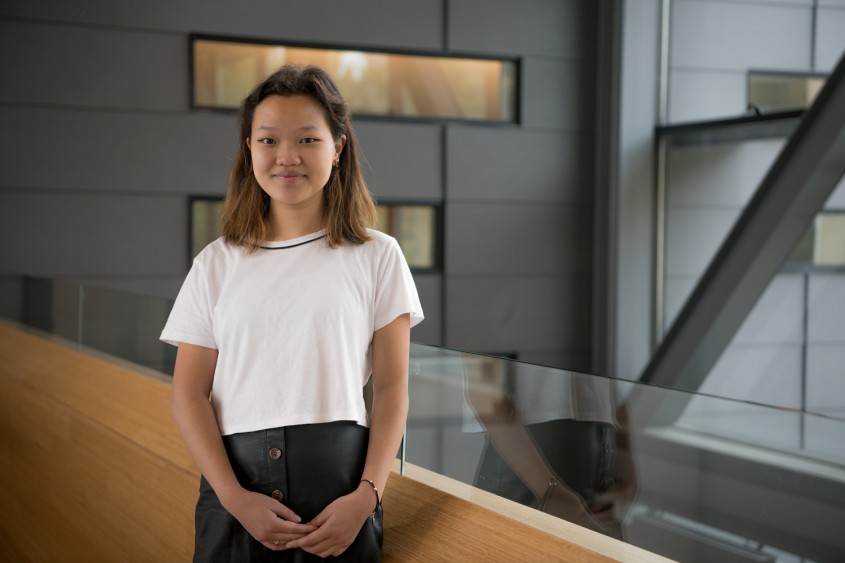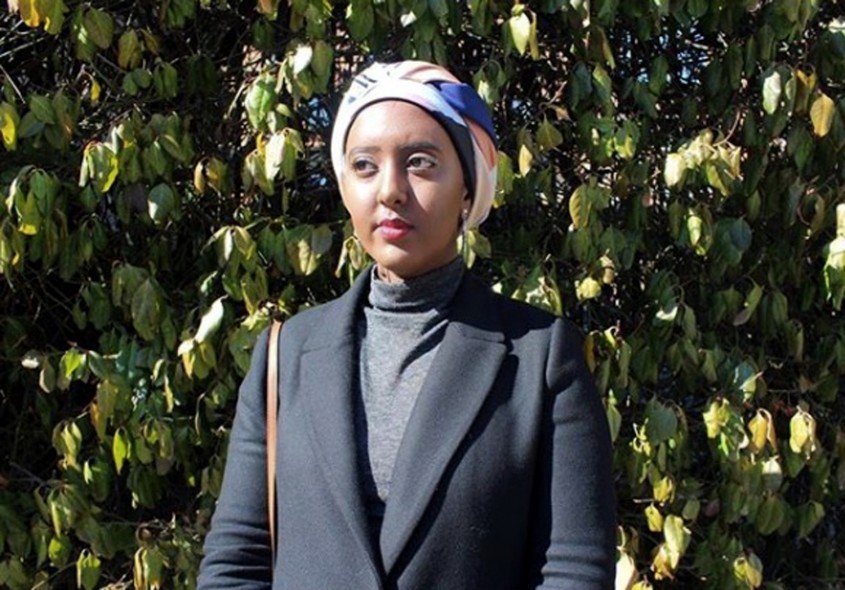Five U of T Scarborough students and recent alumni are featured in The Unpublished City, Volume II, a collection of creative non-fiction that explores the different faces, voices and corners of Toronto.
Published this past summer, the stories weave a tapestry of personal themes including cultural identity, discovering community, racism as well as addiction and mental health.
The authors – who are all very good friends – got their start in creative writing, most notably under Daniel Tysdal (associate professor) and Andrew Westoll, (assistant professor) in the Department of English at U of T Scarborough. Westoll is also the only non-fiction professor at U of T Scarborough.
“The effect of teachers in this school is just so strong. When you have that ability to inspire students the way that they do, I think that is one of the most beautiful things in the world,” says Leanne Toshiko Simpson, a former student of both professors and contributor to the book.
Tysdal says his approach to teaching creative writing has always been to give students hands-on experience, to allow them to tell their own stories and find their own voice.
Seeing five of his students published in the same publication has left him overjoyed.
“I’ve seen how hard they work and how they support one another,” Tysdal says. “They’ve earned this and it’s been the greatest honour to work with these amazing students.”
These are their Scarborough stories.
Natasha Ramoutar
Nestled beyond a small entrance between Progress Avenue and Midland Avenue is unit 5, where Natasha Ramoutar practices capoeira, an Afro-Brazilian martial art. It’s where the group has found a new home.
This isn’t their first. The group has found homes in many of Scarborough’s industrial buildings. What’s more, where many see a cold, industrial space, Ramoutar sees the vibrancy in the community that lies within.
“I wanted to tell a story that moves around places and paints the full portrait of what we went through, moving spaces so many times,” says Ramoutar, who graduated in 2016 with a bachelor of arts in English and French.
In These Four Cement Walls, she traces the journey of her capoeira family as they weave through temporary practice spaces. Through the piece, Ramoutar reflects upon the trial and error of finding the perfect training space.
 A lover of martial arts, she found community in capoeira when she was introduced to it in 2012. She not only fell in love with the history of the martial art but the friendships that flourished with the four cement walls of the gym space in Scarborough’s city centre.
A lover of martial arts, she found community in capoeira when she was introduced to it in 2012. She not only fell in love with the history of the martial art but the friendships that flourished with the four cement walls of the gym space in Scarborough’s city centre.
Seeing the beauty within those paved areas of Scarborough and the vibrant communities that lie within them was part of the inspiration for the story. It also works to break a chain of misconceptions that have plagued the east end.
“I really wanted to show those secluded spaces that you don’t see in Scarborough,” Ramoutar says. “I think Scarborough is often overlooked and has been this place that is sensationalized, where there is a lot of violence.”
But she says Scarborough is having a “creative moment.”
From Nuit Blanche’s east-end debut to the inclusion of the Scarborough experience in this publication, Ramoutar thinks there isn’t a better time to start shedding light on Scarborough’s creativity.
“Reclaiming that narrative is very important. It feels as though there is a historical moment happening right now,” she says. “Seeing different and vibrant cultures come together has always inspired me as a writer — seeing different people from different walks of life coming together pushes me to tell my own truth.”
Ryanne Kap
Ryanne Kap was five years old when she visited Toronto’s Chinatown. In her latest piece, she leads us through the smells of food and rows of jade necklaces as she begins her search in understanding her culture. Of course, this is something she didn’t know at the time. But her return trips to the downtown landmark are the beginning of finding cultural belonging.
Kap’s piece Navigator reflects upon her search for cultural belonging. Having lived in both London and Strathroy Ont., she had previously written about her experiences of being adopted for her creative writing class. When the opportunity to write for The Unpublished City emerged, she took it as an opportunity to further delve into her journey and questions of belonging.
“London, as I knew it, wasn’t diverse. Going to Chinatown at a young age still felt foreign, but there was still that realization that people looked like me,” says the third-year English student. “That confusion if I belonged there or not is still something I’m exploring.”
 Quite literally, the title also refers to Kap getting lost on her trips downtown. Having moved to Scarborough for university, she still has to use Google Maps to get around. Moving from a small town to the city makes it easy to get lost. It’s also a chance to explore new surroundings and find a new place to call home.
Quite literally, the title also refers to Kap getting lost on her trips downtown. Having moved to Scarborough for university, she still has to use Google Maps to get around. Moving from a small town to the city makes it easy to get lost. It’s also a chance to explore new surroundings and find a new place to call home.
Digesting the different landmarks in the city has informed her writing through the understanding of “how varied everyone’s experiences with the city will be” says Kap.
Despite the proximity of those landmarks, everyone has lived different lives and connects to them in various ways. They find ways to co-exist.
“In a small town, if you have any diversity, it’s singled out in ways that are not welcoming,” Kap says. Her search for community is as much physical as it is emotional. There is still a lot more she wants to learn about her Chinese culture — it’s something she wants to physically explore.
It’s a feeling she is not only exploring downtown but in Scarborough as well.
“There is so much diversity in Scarborough and being able to see that and live with that every day is refreshing,” she says. On the other hand, she is almost stuck in the binaries of all the places she has lived. It sometimes doesn’t feel as if she has left her small town at all.
She says telling those stories of not just the city, but of Canada, is equally important and refreshing as a young writer.
“Saying that the city is diverse is one thing,” says Kap. “Actually reading about these experiences is another. Expanding your knowledge of what the city means to others expands your understanding of what the city is yourself.”
Leanne Toshiko Simpson
In Sparks, Leanne Toshiko Simpson walks through the grounds of Toronto’s Centre for Addiction and Mental Health (CAMH).
While she now facilitates creative writing workshops at CAMH, Simpson herself was once on a long waitlist of names hoping for psychiatric help. It’s something she wants to draw attention to.
“I know that if I wait any longer, the sparks in my stomach will latch on to the kindling of my bones, and I will catch fire,” reads the final line.
The author, who has bipolar disorder, reflects on a time of her life where she says she felt “dissociated.” Much of her work about those experiences aims to break the harmful stereotypes around mental illness.
“When people with lived experience write their own stories and get their accurate narratives out in the world, it does two things,” Simpson explains. “It helps combat those negative stereotypes but it also helps people see themselves as protagonists of their own stories and put their hardships in perspective.”
Journaling her day-to-day experiences is a way for her to cope with her mental illness. “I think it’s a very powerful tool,” Simpson says. It’s a way for her to reflect and see how far she’s come.
Simpson is currently writing a romantic comedy novel for people with mental illness, focusing on recovery. She is also working on a resource book for hospitals with creative writing exercises for patients facing mental health and addictions challenges.
“When you’re in the hospital there is a lot of downtime,” says Simpson, who was hospitalized during her time at U of T Scarborough. “If you can develop a skill like writing when you are in there, it’s something you can carry with you through the rest of your recovery.”
While she didn’t write about her Scarborough home this time around, having this kind of representation is something she thinks is important. The anthology searched for essays that were unheard of and didn’t just “paint over” stories of the city that were already heard.
“Scarborough is a place that, especially in the arts scene, is pulsing because we have so much to write about and no one has really listened before.”
Téa Mutonji
“Scarborough is uncomfortable – It’s kind of what makes it Scarborough,” says Téa Mutonji, who majored in Media Studies at UTSC. “It made me be OK with sharing my story.”
Street by Street – Anecdotes For My Mother maps the author’s experiences since she moved back to Scarborough in 2012. Her memories draw upon relationships, mental health, substance abuse and her research on sexual assault during a time where she was predominantly surrounded by women.
Mutonji and her family moved to Scarborough from Congo in 1999. The family eventually moved to Oshawa but Mutonji moved back to Scarborough in 2012 – she recently returned home last month.
 “My mother was the one who asked me to move back home,” she says. Writing down these experiences was a way of saying “sure, I can come home but you should know some footnotes.”
“My mother was the one who asked me to move back home,” she says. Writing down these experiences was a way of saying “sure, I can come home but you should know some footnotes.”
Telling the story of what her life alone in the east-end has been like is something she describes as a “shocking experience.” She says that she was “almost afraid” of writing about herself because writing leaves one exposed and in a way vulnerable. She also hesitated because she didn’t want to make anyone uncomfortable.
But what inspires Mutonji about her hometown is its authenticity. Scarborough is the place where she has had her best and worst experiences. “There is no need to be sad or to cry or mourn,” she says. “It’s just life.”
“When you are in Toronto and you are looking at Scarborough, of course, you are looking at the struggle and the poverty and the immigration. Scarborough is kind of where you admit to what’s happening.”
It was also a goodbye to a part of the city that is a great part of her.
“I tend to think of Scarborough as a character. I think that living here has had such a great impact on my life.”
Oubah Osman
“Some people don't deserve your eyes and ears, let alone your mind.”
This is what Oubah Osman’s mother told her when she was seven years old after she asked about a racist encounter they had with a woman on the bus. It is a situation that Osman says she has kept in a “closed box” inside her.
“I felt like there was this one story that I had always wanted to tell but never really had the capacity to tell,” says Osman, an English literature graduate.
 Confessing tells the story of how Osman has carried that memory with her during childhood and into her adult life. Through the narrative, the author describes experiencing flashbacks of the encounter years later at a protest, and what she felt seeing that same woman decades later in a Scarborough doctor’s office.
Confessing tells the story of how Osman has carried that memory with her during childhood and into her adult life. Through the narrative, the author describes experiencing flashbacks of the encounter years later at a protest, and what she felt seeing that same woman decades later in a Scarborough doctor’s office.
While the piece is about watching a parent experience racism, and how that memory has followed her through her life, it is also told through Osman’s observations of her mother and the ways she shaped Osman’s perspectives on dealing with racism.
“I sat shivering as my mother held my hand and stared outside of the tiny, square window, her chin raised, she scans, elegantly, the traffic below,” one line reads.
Osman, an Ottawa native, moved to Scarborough at two years old. Scarborough, to her, means family.
“It was important to talk about Scarborough and to make my reader interact with the landscape of the city in different ways,” Osman says. “Scarborough is such an important part of my interior and exterior.”
“Life is so much greater and life is so much more interesting than the constructs that we have created around each other's bodies and around our own bodies.”
